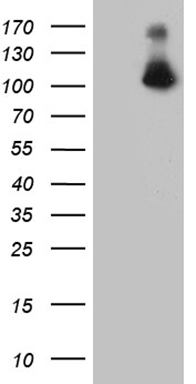DDX50 Mouse Monoclonal Antibody [Clone ID: OTI4F7]
USD 436.00
USD 200.00
USD 867.00
Specifications
| Product Data | |
| Clone Name | OTI4F7 |
| Applications | IHC, WB |
| Recommended Dilution | WB 1:500~2000, IHC 1:1000 |
| Reactivities | Human, Mouse, Rat |
| Host | Mouse |
| Isotype | IgG2b |
| Clonality | Monoclonal |
| Immunogen | Human recombinant protein fragment corresponding to amino acids 1-287 of human DDX50 (NP_076950) produced in E.coli. |
| Formulation | PBS (pH 7.3) containing 1% BSA, 50% glycerol and 0.02% sodium azide. |
| Concentration | 1 mg/ml |
| Purification | Purified from mouse ascites fluids or tissue culture supernatant by affinity chromatography (protein A/G) |
| Conjugation | Unconjugated |
| Storage | Store at -20°C as received. |
| Stability | Stable for 12 months from date of receipt. |
| Predicted Protein Size | 82.4 kDa |
| Gene Name | DEAD-box helicase 50 |
| Database Link | |
| Background | DEAD box proteins, characterized by the conserved motif Asp-Glu-Ala-Asp (DEAD), are putative RNA helicases. They are implicated in a number of cellular processes involving alteration of RNA secondary structure such as translation initiation, nuclear and mitochondrial splicing, and ribosome and spliceosome assembly. Based on their distribution patterns, some members of this DEAD box protein family are believed to be involved in embryogenesis, spermatogenesis, and cellular growth and division. This gene encodes a DEAD box enzyme that may be involved in ribosomal RNA synthesis or processing. This gene and DDX21, also called RH-II/GuA, have similar genomic structures and are in tandem orientation on chromosome 10, suggesting that the two genes arose by gene duplication in evolution. This gene has pseudogenes on chromosomes 2, 3 and 4. Alternative splicing of this gene generates multiple transcript variants, but the full length nature of all the other variants but one has not been defined. [provided by RefSeq, Jul 2008] |
| Synonyms | GU2; GUB; mcdrh; RH-II/GuB |
| Reference Data | |
Documents
| Product Manuals |
| FAQs |
| SDS |
Resources
| Antibody Resources |
Other Versions
| SKU | Description | Size | Price |
|---|---|---|---|
| CF811893 | Carrier-free (BSA/glycerol-free) DDX50 mouse monoclonal antibody,clone OTI4F7 |
USD 564.00 |
|
| TA811893AM | DDX50 mouse monoclonal antibody,clone OTI4F7, Biotinylated |
USD 509.00 |
|
| TA811893BM | DDX50 mouse monoclonal antibody,clone OTI4F7, HRP conjugated |
USD 509.00 |
|
| TA811893S | DDX50 mouse monoclonal antibody,clone OTI4F7 |
USD 200.00 |
{0} Product Review(s)
Be the first one to submit a review






























































































































































































































































 Germany
Germany
 Japan
Japan
 United Kingdom
United Kingdom
 China
China









